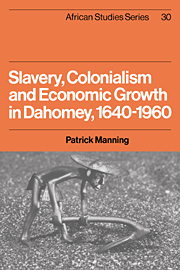Book contents
- Frontmatter
- Contents
- Maps
- Tables
- Figures
- Preface
- 1 Slavery, colonialism and economic growth, 1640–1960
- 2 The Dahomean economy, 1640–1890
- 3 Struggles with the gods: economic life in the 1880s
- 4 Production, 1890–1914
- 5 Demand, 1890–1914
- 6 Exchange, 1890–1914
- 7 The alien state, 1890–1914
- 8 Social struggles for economic ends, 1890–1914
- 9 The mechanism of accumulation
- 10 Capitalism and colonialism, 1915–60
- 11 The Dahomean national movement
- 12 Epilogue
- Notes
- Appendix 1 Export revenue from Dahomey, 1640s–1950s
- Appendix 2 Slave exports by ethnic origin
- Appendix 3 Population loss due to slave exports
- Appendix 4 Foreign trade of Dahomey
- Appendix 5 Foreign trade indices
- Appendix 6 Rainfall
- Appendix 7 Fiscal flows
- Appendix 8 Money supply of colonial Dahomey
- Bibliography
- Index
9 - The mechanism of accumulation
Published online by Cambridge University Press: 26 October 2009
- Frontmatter
- Contents
- Maps
- Tables
- Figures
- Preface
- 1 Slavery, colonialism and economic growth, 1640–1960
- 2 The Dahomean economy, 1640–1890
- 3 Struggles with the gods: economic life in the 1880s
- 4 Production, 1890–1914
- 5 Demand, 1890–1914
- 6 Exchange, 1890–1914
- 7 The alien state, 1890–1914
- 8 Social struggles for economic ends, 1890–1914
- 9 The mechanism of accumulation
- 10 Capitalism and colonialism, 1915–60
- 11 The Dahomean national movement
- 12 Epilogue
- Notes
- Appendix 1 Export revenue from Dahomey, 1640s–1950s
- Appendix 2 Slave exports by ethnic origin
- Appendix 3 Population loss due to slave exports
- Appendix 4 Foreign trade of Dahomey
- Appendix 5 Foreign trade indices
- Appendix 6 Rainfall
- Appendix 7 Fiscal flows
- Appendix 8 Money supply of colonial Dahomey
- Bibliography
- Index
Summary
GROWTH, 1890–1914
To a first approximation, the economy of southern Dahomey did not change in the early colonial years: the methods of production, the types and quantities of goods produced and consumed, and the economic organization of society all remained much the same on the eve of World War I as they had been on the eve of the French conquest. Descriptions of the economy are remarkably similar from the beginning of this period to the end.
To a second approximation, such change as took place consisted mostly of fluctuation and redistribution of output and wealth. Most basic were the fluctuations caused by weather, disease, and conditions in local and world markets; then came the redistribution resulting from the fortunes of inheritance and marriage, and from the uneven quality of decisions on production and investment. The most spectacular redistribution of wealth and resources resulted from the colonial conquest: as the old states were destroyed or subordinated to the new, the privileges held by royalty and its allies were voided, and could only be reaffirmed through ties to the French state. As a result there occurred a partial replacement of one economic elite with another, with European merchants, for example, gaining a new advantage over Dahomeans.
Only at the level of a third approximation does the significance of net change become apparent, for it was relatively small in magnitude and difficult to distinguish unambiguously from short-term fluctuations. But in the early colonial years export volume grew by an average of over 2.5% per year, imports of major consumer goods rose at .3.5% per year, and population grew by an average 1.5% per year.
- Type
- Chapter
- Information
- Slavery, Colonialism and Economic Growth in Dahomey, 1640–1960 , pp. 217 - 229Publisher: Cambridge University PressPrint publication year: 1982



